Although manta and sharks are from the same class of animal, but Manta Rays don’t have the same sharp teeth that sharks have. Instead of sharp teeth, they belong to rows of tiny plates inside their mouth called gill rakers. The gill rakers are often compared to teeth. You will find their mouth (also called the “terminal” mouth) between the cephalic fins or front of their head.
However, there are many controversies in the digital world about whether they have actual teeth or not. Still, it creates doubt, and if you spend your time, you will find some reports saying that they have 18 rows (somewhere around 300 rows) of tiny, peg-like teeth. Huh!!! A mystery within a mystery, isn’t it?
However, in this blog post, I will explore the answer to this question and other interesting facts about manta rays. So, whether you’re an ocean lover, marine enthusiast, or just someone curious about the world, read on to discover more about these amazing creatures and their teeth!
Do Manta Rays Have Teeth?
It is said that the manta rays come with specialized filter-feeding structures called “gill rakers,” comparable to teeth.
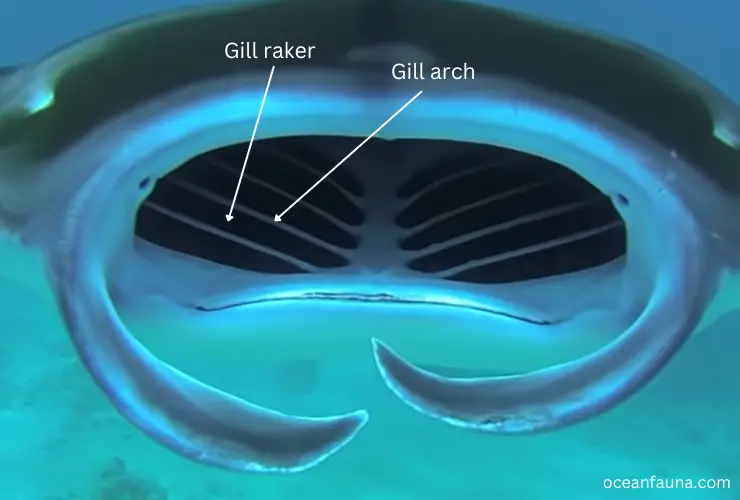
Anatomy of gill rakers
They use these special structures to filter small prey from the water. Some research claims that these tiny structures are referred to as teeth. But it’s a matter of debate whether these are actually known as teeth or not.
Now the question is how many rows of gill rakers are there in manta rays’ structural formation.
Anatomically, it is said that there are 18 rows of gill rakers (so-called teeth) found on manta rays’ structural formation, which resembles a little larger than the head of the pin.
In your open eye, you can mark these rows as teeth found in this creature’s lower jaw. If you culture these rows of gill rakers, then you will find 12 to 14 rows at the corners of manta rays’ mouths. Interestingly, some larger teeth-like structures are also located at the upper jaws of these ocean mysteries.
Note: I am astonished that a study regarding the biology of manta rays claimed that there are 300 rows of peg-like teeth.
Functions of gill rakers
The gill rakers are made of cartilage and act like a sieve to trap food particles as water passes through the manta ray’s mouth and over the gills.
This allows them to feed efficiently on tiny organisms like plankton and small fish. It is important to note that while many species of rays have teeth, manta rays are filter feeders and do not require teeth for their feeding mechanism.
Do Manta Rays Use Their Teeth to Defend Themselves?
Although the teeth of manta rays are a controversial fact, it is proven that their defense mechanism is different and not related to teeth. Really!!! Yes, you hear the right sound. Oh, God’s blessing. Then, let me breathe; at this point of discussion, I felt freedom.
Let’s go back again to their defense mechanism. Yeap, one of the primary defense mechanisms of manta rays is their size.
They are one of the largest ray species, with wingspans of up to 23 feet (7 meters), which can be intimidating to potential predators.
Additionally, manta rays have thick skin that is difficult to penetrate, and they are able to swim very quickly to escape danger.
Other than this, Manta Rays have a defense mechanism called ‘flight’. They have been observed leaping out of the water when they feel threatened, which can startle or confuse their predators.
They may also use their powerful tails to deliver a swift blow to a potential attacker.
Overall, while manta rays do not have teeth for defense, they have evolved a number of other adaptations to help them survive in their marine environments.
What Type of Mouth Do Manta Rays Have?
Manta rays have wide, terminal mouths. Their mouths are at the front of their bodies, underneath the head, and are wide and flattened.
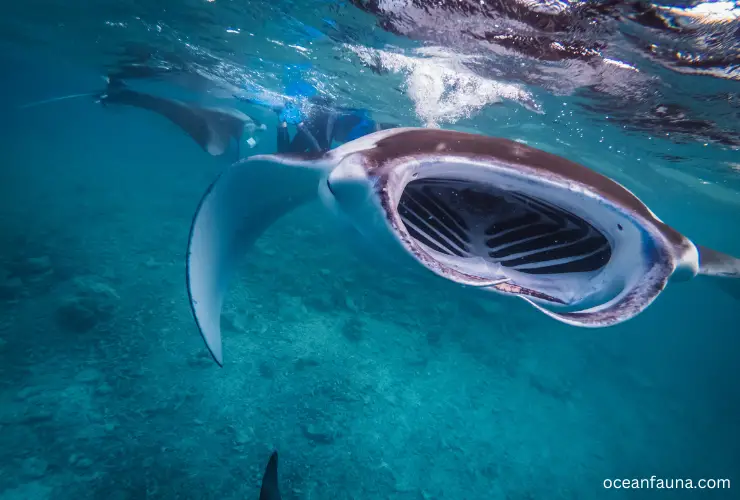
The mouth is surrounded by large, triangular-shaped cephalic lobes that help funnel water and food into the mouth.
The terminal mouth allows the manta ray to easily capture large quantities of water. This will also help them to engulf the small planktonic organisms that it feeds on as it swims through the water with its mouth open.
The wide terminal mouth of the manta ray is a key adaptation for its filter-feeding lifestyle. The wide terminal mouth of the manta ray is an important part of its anatomy and plays a crucial role in its feeding strategy.
Are Manta Rays’ Mouth Always Wide Open?
Yes, Manta Ray’s mouth always remains open. Manta rays are filter feeders, which means they feed on plankton and small fish by filtering them out of the water.
To do this, they swim with their mouths open, which allows water to flow in and over their gill plates, where they capture their food.
Constant swimming with their mouths open also helps manta rays maintain a steady flow of oxygen-rich water over their gills, which is essential for respiration.
This behavior also allows them to efficiently filter large amounts of water to capture enough food to sustain their large size.
Why Do Manta Rays Have Mouth Flaps?
Manta rays have a unique adaptation in their mouth called “cephalic lobes” or “mouth flaps.” These flaps on the front of the manta ray’s head guide water and prey into its open mouth.
As filter feeders, manta rays rely on a constant flow of water over their gills to extract oxygen and filter out plankton and small fish.
The mouth flaps act as a funnel, directing water and prey toward the manta ray’s mouth, where they can be efficiently filtered out of the water.
The flaps also allow manta rays to control the water flow over their gills, ensuring a steady supply of oxygen-rich water. In addition, they may also help to reduce turbulence around the manta ray’s mouth as it swims, making it easier to capture prey.
Overall, mouth flaps are an important adaptation for manta rays, enabling them to feed and breathe effectively in their ocean environment.
How Do Manta Rays Consume Food?
I already talked about Manta rays’ specialized gill rakers. Mainly, this specialized structural formation acts like a sieve, trapping plankton as the water passes through their gills.
To feed, manta rays swim with their mouths open, allowing water to flow in through their giant, forward-facing mouths. As the water passes over their gills, the gill rakers trap the planktonic organisms, which the manta ray then swallows.
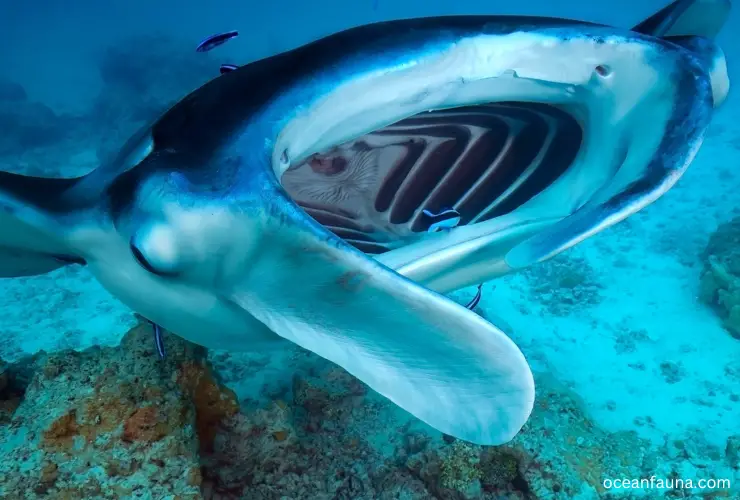
Manta rays also have a specialized feeding behavior called “barrel-rolling,” where they somersault through the water while feeding.
This behavior helps them maximize their feeding efficiency. Also, this will allow them to capture a greater number of plankton in a shorter amount of time.
Manta rays also feed on small fish, squid, and crustaceans, which they capture by swimming close to the water’s surface and scooping them up with their large, flexible pectoral fins. However, plankton makes up the majority of their diet.
How Do Manta Rays Chew?
Manta rays do not chew their food as humans do. Instead, they have a specialized filtering system that allows them to feed on plankton and other tiny organisms.
Manta rays have large, wing-like pectoral fins that filter food out of the water. And as mentioned above, they open their mouths wide as they swim, allowing water and plankton to flow in.
Actually, they swallow the food and expel any excess water through their gills.
While manta rays do not chew their food, they have a very efficient digestive system that allows them to extract all the nutrients they need. They can break down and digest their food quickly, which helps them maintain their energy levels and grow to their full size.
FAQs
Do Manta Rays Have Sharp Teeth?
No, although manta rays are large and impressive creatures, but they don’t have sharp teeth. Instead, manta rays have specialized tiny organs (we discussed above), which consist of comb-like structures that line the inside of the manta ray’s mouth.
Can Manta Rays Bite You?
Manta rays are generally not considered dangerous to humans and do not have teeth, which means they cannot bite you.
However, like any wild animal, manta rays may exhibit defensive behaviors if they feel threatened or provoked.
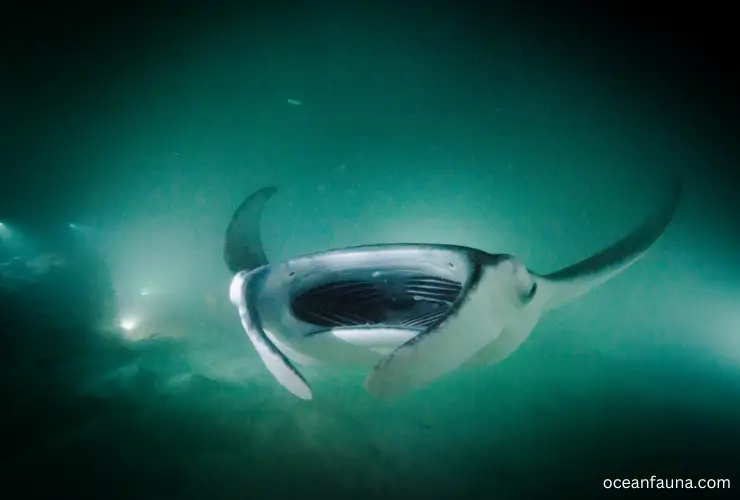
If a human were to intentionally or unintentionally harass or harm a manta ray, it might defend itself by flapping its wings or using its tail spine.
So, while manta rays are not known for biting humans, it’s essential to treat them with respect and caution and maintain a safe distance to avoid any potential harm.
Can a Manta Ray Eat or Swallow a Human?
No, a manta ray cannot eat or swallow a human.
Manta rays are filter feeders, meaning they feed by filtering tiny organisms like plankton and krill from the water using their large, specialized gill plates.
They do not have the anatomical features to swallow large prey like humans.
Conclusion
Finally, manta rays do have a mouth, but they do not have traditional teeth. comb-like structures called gill rakers, compared to teeth.
They can consume a large amount of food each week, but the specific amount can vary depending on factors such as the size of the animal and the availability of food sources. A manta ray’s estimated amount of food in a day is almost 60 pounds.

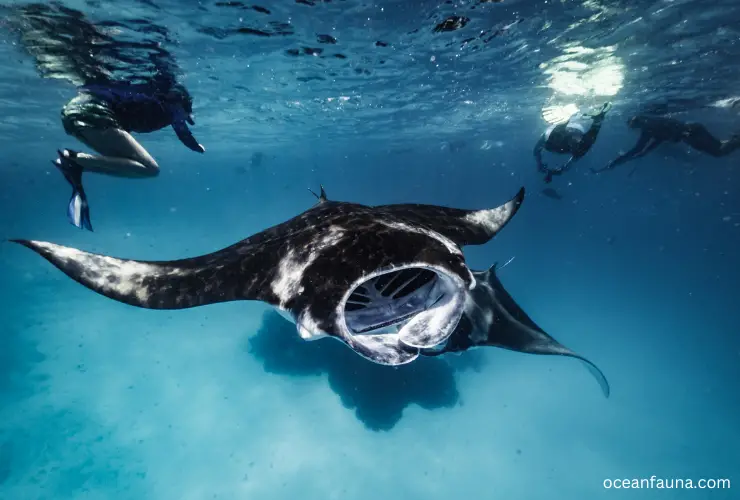
3 thoughts on “Do Manta Rays Have Teeth and Mouth?”